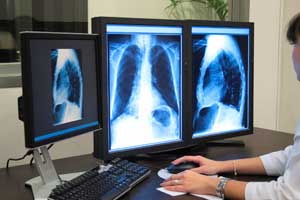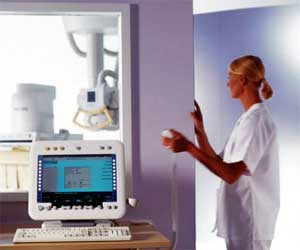Diagnostic Radiologist
Tasks & duties

Diagnostic radiologists may do some or all of the following:
-
advise doctors on the best radiographic examination to perform on a patient
-
explain examination procedures to patients beforehand, and discuss the results with them afterwards
-
supervise medical radiation technologists when they perform radiographic examinations on patients
-
perform examinations that medical radiation technologists are not qualified to perform
-
interpret images from radiographic examinations, which may include MRI, ultrasound and nuclear medicine
-
review examination with the patient's doctors
-
perform biopsies (taking tissue for diagnosis) from areas such as breasts, liver, kidneys and lesions
-
teach other health professionals such as medical students, trainee radiologists, medical radiation technologists and nurses
-
perform administrative duties
Interventional radiology is a subspecialty of radiology with an emphasis on using minimally invasive procedures. Interventional radiologists may do some or all of the following:
-
treat some diseases guided by imaging equipment
-
insert catheters through the skin to drain abscesses, unblock kidneys, or drain bile from the liver
-
unblock arteries using techniques such as angioplasty or thrombolytic therapy
Specialisations
Gastrointestinal radiologist
Gastrointestinal radiologists specialise in stomach, intestine, and bowel imaging.
Mammographer
Mammographers specialise in breast imaging.
Musculoskeletal radiologist
Musculoskeletal radiologists specialise in imaging muscles and bones.
Neuroradiologist
Neuroradiologists specialise in brain imaging.
Cardiovascular radiologist
Cardiovascular radiologists specialise in heart and blood vessel imaging.
Radiobiologist
Radiobiologists study the effects of radiation on living organisms.
Paediatric radiologist
Paediatric radiologists specialise in imaging for children and babies.
Genitourinary radiologist
Genitourinary radiologists specialise in imaging reproductive organs and urinary tracts.
Skills & knowledge

Diagnostic radiologists need to have:
-
communication and people skills to relate well to patients and colleagues
-
knowledge of anatomy and how the human body works
-
knowledge of different diseases and illnesses
-
knowledge of medicines and treatments, and the effect these have on patients
-
knowledge of radiographic methods and the safe handling of unsealed radioactive sources
-
an understanding of the physics related to radiation theory
-
decision-making and problem-solving skills
-
diagnostic skills
-
analytical and interpreting skills
-
the ability to carry out minor surgical procedures such as putting in stitches
-
an awareness and understanding of other cultures and their attitudes to medical treatment
-
organisational and time management skills
-
report writing skills
-
up-to-date knowledge of new research, treatments and practices
-
knowledge of medical ethics and law
Entry Requirements
To become a diagnostic radiologist you need to complete a Bachelor of Medicine and Bachelor of Surgery (MbChB) and spend at least two years as a junior house surgeon in a hospital. You must then complete at least five years of specialist training and examinations to become a fellow of the Royal Australasian College of Radiologists or have an equivalent overseas qualification.
Entrance into the radiology training programme is competitive and many diagnostic radiologists will begin surgical, paediatric or obstetrics training while applying for the training programme.
Secondary Education
A tertiary entrance qualification is required to enter further training. Useful subjects include Bursary or NCEA equivalent maths, chemistry, physics, biology and English.
Tertiary Education
To enter the MBChB you need to complete the first year of a Bachelor of Health Science or a Bachelor of Science (Biomedical), and undertake the Undergraduate Medicine and Health (UMAT) admission test, where up to one-third of your first year final grade is determined by non-academic achievements.
Alternatively, you can complete a related health sciences degree and apply for graduate entry to the MBChB programme. Graduate applicants must also undergo the UMAT admission test.
Training on the job
Diagnostic radiologists must take part in continuing education courses through their fellowship college. In the programme administered by the Royal Australasian College of Radiologists, diagnostic radiologists are required to complete a number of educational credits every three years, with a maximum number of credits to be completed in any one year. They also need to keep up to date with the latest technology and practices through reading medical journals and using the Internet.
Registration
Diagnostic radiologists need to be registered with the Medical Council of New Zealand.
Related courses
Medical Imaging Technology (Radiography) and Radiation Therapy
Medical Science
Radiology
For more information, please refer to Career Services.
Document Actions
